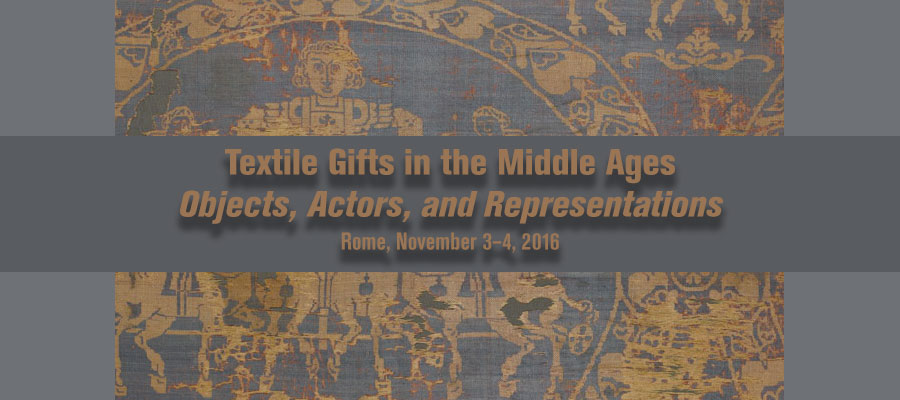Textile Gifts in the Middle Ages – Objects, Actors, and Representations, Rome, November 3–4, 2016
As art history has given greater attention to material culture and its social contexts as a whole, the applied arts have also re-entered the scope of art historical discourse. Cultural-historical approaches, such as those employed in material culture studies, explore the objectness of artifacts and their efficacy. Related are studies of objects as mediums of symbolic communication, in which such objects are described and interpreted as part of complex performances of ritual and ceremony. Gifts of textiles in the Middle Ages provide a test field for the evaluation of such questions and approaches for the discipline of art history.
Gifts of textiles and clothing appeared in diverse contexts and fulfilled various functions in pre-modern Europe. They could be offered in the course of an initiation rite and or an act of social transition, including upon investiture, marriage, or entry into a monastery. Gifts of clothing to the poor, meanwhile, were among the works of charity thematized in the vitae of numerous medieval saints. Sumptuous textiles were sent as resplendent gifts to religious institutions or, like patterned silk textiles from Byzantium, circulated through diplomatic gift exchanges. Gifts of clothing were also distributed within the court as compensation in kind, which supported the structuralization and hierarchization of courtly society. Gifts of clothing could represent the donor. Especially in the case of clothing previously worn by its donor, the physical presence of the giver might have been woven into the materiality and form of the gifted garment.
The goal of this interdisciplinary conference is to situate the diversity and polysemy of such acts of symbolic communication into the broader context of medieval gift culture.
Already in the 1920s, Marcel Mauss showed that gift giving established social relationships and was composed of three necessary elements: giving, accepting, and reciprocating (the “principle of reciprocity”). At play in such exchanges is essentially the construction of power and social hierarchies. While Mauss’ theory has long been employed within medieval studies, recent criticism has pointed out that the particular efficacy resulting from the material and visual qualities of gifts has not been sufficiently addressed, as studies applying Mauss’ model concentrate primarily on donors, recipients, and their interaction. In other words, the context of the exchange has been privileged over the objects of exchange (Cecily Hilsdale, 2012). With its focus on images and objects, art history is poised to show how the dynamics of reciprocity and its attendant obligations might be charged both visually and materially.
The conference focuses on textile gifts in pre-modern Europe in order to explore such questions in greater detail. The integration of anthropological models into an art historical approach allows for gifted artifacts to be taken seriously as independent entities within the giving process as a socially generative form of communication. The relationship between the actors and the “agency” of gifts themselves can therefore be further explored (Bruno Latour).
We invite paper proposals from the field of art history and related disciplines, such as history, anthropology, archaeology, and literature. Papers might address the following subjects in particular:
Textile gifts as acts of symbolic communication in the Middle Ages
Especially welcome are case studies that illustrate the act of giving and the sense of obligation generated between donor and recipient and that, in so doing, attend to the visual and material efficacy of textile gifts. Papers might consider gifts of personal garments, like the gifting of a sovereign’s mantle to an ecclesiastical institution, and the honor—or affront—such gifts might entail.
Methodological reflections on the suitability of anthropological models for medieval art history
How helpful are anthropological models (Marcel Mauss’ gift theory and its lineage) in understanding and interpreting pre-modern textile gifts? We begin with the premise that no single general theory is capable of explaining every gift act definitively. Rather, a number of approaches originating in Mauss, some of which are controversial, could be debated within the context of medieval textile gifts.
The relationship of textile gifts as performative acts to their representations
How were medieval textile gifts represented in word and image? What relationship do these representations have to their material prototypes (surviving textile gifts) and their contexts (acts of donation)?
Gendered aspects of textile gifts
Could textile gifts in the Middle Ages be gender-specific? Can we observe different behavioral patterns in the gifting practices of men and women?
Re-use and re-contextualization of textile gifts
The appreciation, use, and conservation of medieval textile gifts, including their restoration or alteration, can reveal much about how recipient institutions dealt with their donations. How, for example, did recipients interpret and use textile gifts in the formation of their identities? How did such a process shape the relationship between a recipient institution and its donor?
